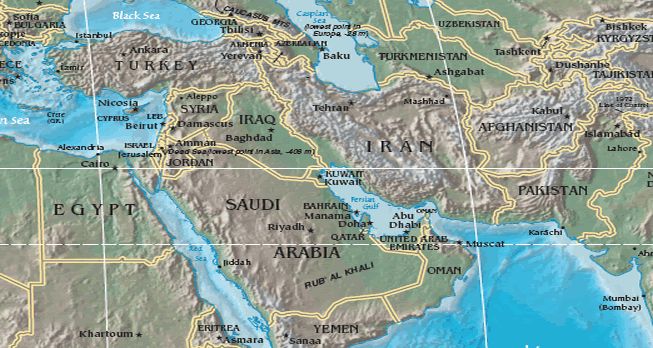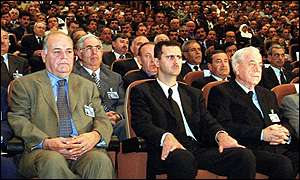 There have been two Ba’ath Party regimes in the Middle East during the 20th century. While they are divergent factions of that particular political ideology, one finds in this analysis that the Ba’ath parties of Iraq and Syria hold key similarities that allow for transformation into successful authoritarian regimes. Once in power, the Ba’ath Parties shift, under the leadership of Bakr-Hussein and Asad, from an ideologically driven freedom movement to a fear-driven authoritarian institution. By analyzing the principles of the Ba’ath Party from its conception to its development in both the Syrian and Iraqi cases, one can see that the Ba’ath Party allowed minority factions to position themselves for political domination over other sectarian groups. First, the essay will outline the principles of the Ba’ath Party. Secondly, the essay will analyze the failure of the UAR and its impact on the Ba’ath Party’s direction. Thirdly, the essay will explore the commonalities of militarism and minority dominance between Iraqi and Syrian Ba’athist regimes. Finally, the essay will show that the Ba’ath Party was a means for the creation of uniquely similar authoritarian regimes such as they existed in the time period of 1963-1980 in Syria and Iraq.
There have been two Ba’ath Party regimes in the Middle East during the 20th century. While they are divergent factions of that particular political ideology, one finds in this analysis that the Ba’ath parties of Iraq and Syria hold key similarities that allow for transformation into successful authoritarian regimes. Once in power, the Ba’ath Parties shift, under the leadership of Bakr-Hussein and Asad, from an ideologically driven freedom movement to a fear-driven authoritarian institution. By analyzing the principles of the Ba’ath Party from its conception to its development in both the Syrian and Iraqi cases, one can see that the Ba’ath Party allowed minority factions to position themselves for political domination over other sectarian groups. First, the essay will outline the principles of the Ba’ath Party. Secondly, the essay will analyze the failure of the UAR and its impact on the Ba’ath Party’s direction. Thirdly, the essay will explore the commonalities of militarism and minority dominance between Iraqi and Syrian Ba’athist regimes. Finally, the essay will show that the Ba’ath Party was a means for the creation of uniquely similar authoritarian regimes such as they existed in the time period of 1963-1980 in Syria and Iraq.
The foundation of the Ba’ath movement and subsequent political party begins with the perceived state of affairs in post-World War I, particularly in Syria. The Ba’ath (Resurrection) movement was initially led by Michel ‘Aflaq, an Orthodox Christian and Salah al-Din al-Bitar, a Sunni Muslim; both were Syrians from bourgeois Damascus families (1397, Devlin). Their principles were unity, freedom and later socialism, which shaped Ba’ath political dynamics once it achieved party status. While ‘Aflaq believed that the Ba’ath movement’s central purpose was to educate, Bitar believed that a political organization was necessary “for the ideas of the group to be truly influential” (1398, Devlin). The principles of the Ba’ath Party arise from the socio-economic and political context of the 1920s. An understanding of how the (Sunni/Alawite) leaders of Iraq and Syria would use the Party for their rise to power requires an understanding of the principles that ‘Aflaq and Bitar instituted in the founding congress of the Ba’ath Party, which took place on April 4-6, 1947 and the subsequent merger with the Arab Socialism Party of al-Hawrani in 1953. In addition, to better understand how Ba’athism came to be an empty rhetorical shell for authoritarian manipulation in the two Ba’ath regimes, one must first understand the ideology that it put forth.

A vision of pan-Arabism had been growing in the school systems of Syria and Iraq in the interwar years (1397, Devlin). Pan-Arabism was defined as the call for unity between persons who speak Arabic (154, Pfaff). In the 1920s and 1930s, “Arabism came to be defined by language rather than geography” (1397, Devlin), this altered the conceptualization of political interests beyond regionalism. Moving against the arbitrary states installed by western powers, pan-Arabism was a new way of looking at an old historical fact; the fact of Arab oneness. Ba’athism was the first political ideology with pan-Arabism as the primary goal, and had a “leading role in spreading the doctrine of unity in the 1950s” (1399, Devlin). The founding Ba’athist Michel ‘Aflaq stated in his treaties On the Way of Resurrection:
Our Party is an Arab Party in the sense that no other Party is like it. It does not content itself with the affirmation of the Arab idea but endeavors, in reality, besides its idea, to be the comprehensive Arab Party in all the Arab regions. It tackles the Arab problems as an indivisible whole. It does not treat the regional question, including the question of Syria, except in the light of one Arab nation (al-moharer.net, ‘Aflaq).
This collective Arab spirit was a philosophy that would be used to capture the imaginations of party members and outsiders. Pan-Arabism also meant secularism, which is conducive to religious tolerance that is crucial to the rise of the Ba’ath regimes of Syria and Iraq. Pan-Arabism has a strategic political stance that rejects arbitrary political boundaries and bypasses religious and ethnic differences that manipulate allegiances and serve to divide. Arab unity was the most important goal for the Ba’athist founders and explains the quick move toward creating the UAR in 1958.
Another dominant principle that coincides with pan-Arabism in the Ba’ath (Resurrection) movement, was the vehement opposition to western intervention in the Middle East. Anti-Imperialism necessitates the rejection of externalities and inversely demands Arab nationalism, which became a political force “in the decade prior to World War I, when Arab subjects of the Ottoman Empire began to assert their Arabness in opposition to the Turk[s]” (1396, Devlin). Freedom was the second pillar of the Ba’ath Party; a rejection of foreign rule. According to Adeed Dawisha, “the nationalist generation of the 1950s and 1960s came to believe fervently that the West would deliberately and effectively block the goals of Arab nationalism…” (3, Dawisha) adding that the Western powers were threatened by Arab self-determination. With the political borders established by the mandatory powers in the early 1920s, the elite were not interested in general Arab affaires but establishing their own political fortunes in the territories they were bound within. Anti-Imperialism was a reactionary response to the ruling Arab elite, who gained from being an extension of Western imperialism.

The principle of socialism and social justice for the poor and underprivileged developed after the initial stage of the Party’s formation in 1947. The slogan “unity, freedom and socialism” and “One Arab Nation with an Immortal Mission” begin to appear on Party publications in the mid-1950s. ‘Aflaq and Bitar initially rejected the class struggle as a Ba’ath Party principle. However, the April 4-6, 1947 Ba’ath Party convention attracted the support of impoverished minorities such as the Alawi led by Zaki al-Arsuzi supporters. Again, socialism is pertinent for minority involvement in the Party. In addition, Dr. Wahib al-Ghanim recruited his own followers including a 16 year old from the hill village of Qardaha named Hafiz al-Asad (34, Seale). Ghanim was instrumental in adding the importance of socialism to Ba’ath Party doctrine. Ghanim blamed the ruling elite “for [the] conditions and insisted on the inclusion, in the 1947 Party constitution, of clauses calling for social justice: the limitation of agricultural holdings, worker participation in management, and state ownership of heavy industry, natural resources, and public utilities” (1398, Devlin). While ‘Aflaq focused on nationalism and Arab unity, Ghanim imported an awareness of economic and political power of the notables in Syria, stating that they had to be broken if the Ba’ath’s vision of independence was to be achieved (1399, Devlin). With the adoption of socialism in Ba’athist ideology, the Party easily merged with the Akram al-Hawrani’s Arab Socialist Party in 1953 to become the Arab Socialist Ba’th Party. It is important to note, however that the 1947 constitution remains the basic document, in both Iraq and Syria (3, Kienle).
The constitution of 1947 established the Ba’ath Party’s organizational structure. Local Party organizations were set-up in Arab countries other than Syria, such as Transjordan as early as 1947, in Lebanon in 1949, in Iraq, Saudi Arabia and Yemen in 1952 (3, Kienle). In 1954, Regional Commands were established to “reflect the growing importance of its sections outside Syria” (3, Kienle) with a new higher body called the National Command. The National Command was designed to oversee the entire Ba’ath Party with ‘Aflaq and Bitar in control. Members were elected to the national and regional bodies and amendments to the constitution required a vote (3, Kienle). “Despite further changes over the years, this basic structure has survived…with the notable difference that since 1968, to some extent since 1966, there have been two distinct Ba’ath parties” (4, Kienle), one dominated by Syria and one dominated by Iraq.
There are a number of consequences of the 1958-1961 UAR failure for the development and direction of the Ba’ath Party in Syria and Iraq. The Ba’ath Party of Syria developed slowly, gaining support in the government through the 1950s. On April 17th 1956, the Ba’ath Party announced it would work for the union of Egypt and Syria as a first-step toward Arab unity (1399, Devlin). As part of the Pan-Arabism that the Ba’ath Party espoused, they pushed for Egyptian President Gamel Abdel Nasser to resolve the political squabbling of the increasingly factionalized Syrian officer corps (1399, Devlin). Nasser hesitated, but as a proclaimed Pan-Arabist he was obligated to act or be seen as turning away from his declared vision (181, Palmer). As part of the negotiations, Nasser demanded that all political parties be abolished, accept his Arab Socialist Union. The Ba’ath Party, seeing the beginning of the fulfillment of unity doctrine and the assumption of continued influence within the Nasser regime, dissolved unilaterally without consulting the bulk of the Party.

The United Arab Republic episode was a major turning point in Ba’ath Party trajectory and arguably facilitated the collapse of the Ba’athist pan-Arab vision. Firstly, the 1961 collapse of the UAR and subsequent failure to reconcile differences diminished any hope of a union between Syria, Egypt and other Arab states. Ba’athists essentially achieved the unity aim it desired but that aim was de-legitimized by Nasser’s hegemonic approach. Ironically in 1961, Syria, which harbored the most pan-Arabs, would openly reject the practical application of a founding Ba’ath ideological principle (1400, Devlin). Secondly, Syria’s “succession was a powerful demonstration that the states created after World War I had developed great staying power” (1401, Devlin) and made future aspirations for pan-Arabism somewhat unlikely. Instead, neo-Ba’ath ideology in Syria would, from then on, stipulate that “unity of the Arab states was to follow upon the socialist development of each region” (7, Galvani). This stipulation made Arab unity even more remote.
In addition, the failure to consult the elected party bodies, before ordering the dissolution of the Ba’ath Party, set a precedent that moved the Ba’ath Party from an organization with elected commands to one rigidly dominated by those in head leadership positions within the National and Regional Commands (1399, Devlin). “Deeply resenting the National Command’s autocratic behavior, many of those who opposed such a far-reaching unity scheme remained secretly organized and soon became known as the regionalists” (32, Kienle). In fact, a chief cause of tension between Iraq and Syrian Ba’ath factions in 1958 was ‘Aflaq and Bitar’s decision to dissolve the Arab Socialist Ba’ath Party in Syria (31, Kienle). The regionalist faction of Iraq opposed the UAR ideal and a divergence between the two Ba’ath Party factions made union between Iraq and Syria impossible. The primary goal of Bathism; pan-Arabism was effectively dead by the early 1960s.
The Ba’ath Party’s growth was negligible until the aftermath of the UAR, “Ba’athist influence in the military increased the Party’s political clout…the civilian leadership possessed the titles and visibility; the military officers possessed the power (181, Palmer). The Syrian Ba’athists in the military would build an organization of the deepest significance for Syria’s future during the UAR. In 1959, during the first phase of Syrian disapproval of Nasser’s leadership, five Syrian military men with desk jobs in Cairo formed the Ba’ath Military Committee; al-Asad and al-Jadid were the most prominent (33, Kienle). With the break up of the UAR on September 29, 1961, the Military Committee reconstituted the Ba’ath Party (6, Galvani). Al-Jadid and al-Asad were better placed to reform the Party than the civilian Ba’ath leaders, who were greatly discredited by the dissolution of the Party in 1958 and its liquidation into Nasser’s Arab Socialist Union.

The Syrian Military Committee subsequently joined forces with a faction of non-Ba’ath officers and seized power on March 8th, 1963 (6, Galvani). They did this by persuading the Nasserites and independent officers into overthrowing the secessionist government and planned to immediately called for reestablishing unity with Egypt (183, Palmer). Knowing the unity talks would fail, since Nasser blamed the Ba’ath Party for the secession, the Military Committee members purged and exiled their non-Ba’ath associates and brought in civilian Ba’athists into the government. Three years of “an internal coup within the [Syrian] Ba’ath Party ousted the civilian wing of the Party in 1966, placing the military wing of the Party in control of Syria’s affairs” (184, Palmer). On February 23, 1966 the ‘Aflaq-Bitar faction was ousted by force. However, most Iraqi Ba’athists continued to recognize the civilian ‘Aflaq and his colleagues as the legitimate leadership of the political party. As a direct result of their loyalty to the founders, the Iraqi Ba’ath Party offered asylum and the assurance of continued leadership to ‘Aflaq and his Syrian associates. This act further alienated the Iraqi Ba’ath Party from the Syrian faction.

The UAR’s collapse was evidently important because, as a result, military men emerged on the Regional Commands of both Iraq and Syria (1401, Devlin). It is argued that the military’s training in the chain-of-command system gave them the pre-disposition to authoritarian control from the top, leading to the inevitable outcome of Ba’athism’s transformation once a regime formed. The centralization of power in one man holding offices of the Ba’ath Party head was shared in both cases. The Ba’ath parties “haphazard recruiting practices resulted in Ba’athist turning up in field grade officer levels in the Syrian and Iraqi armies by the end of the 1950s” (1402, Devlin). Essentially, the Ba’ath Party slowly became the political ideology of choice for those in the military service in the two cases of Iraq and Syria. The youth were “indoctrinated in political ideology by secondary school teachers in the expanding public school system” (1402, Devlin) and the military was also the avenue for rural minorities in both cases. In Syria, Hafiz al-Asad joined the Ba’ath Party in secondary school and so did many of his contemporaries. As an Alawis minority, al-Asad took advantage of the Ba’ath Party’s openness. Al-Bakr, a minority Sunni Muslim from Takrit, joined the military in Iraq and would later rule that nation-state from 1968 to 1979.

In both nations, the leaders of the Ba’ath Party came from minorities within the autonomy of their respective nations. For minorities, one of the only means of advancement in society was through the military and from the military into the Ba’ath Party with its enticing doctrine of social justice and pan-Arabism. Hafiz al-Asad was attracted to the Ba’ath political association because his interests, as an impoverished and manipulated rural minority, could best be served within it. Meanwhile Syria’s “wealthier Sunnis, by contrast, found military service to be beneath their dignity and concentrated on commerce” (179, Palmer). This helps explain the minority leadership of the Ba’ath Party in both Syria and Iraq. Saddam Hussein, being a minority Sunni Muslim (although not a military officer), took advantage of Ba’athisms secular, pan-Arab doctrine as well. He began his career as a Ba’athist militant in the attempted assassination of Qasim in 1959 (1404, Devlin). Conclusively, the military is the primary means by which minorities gain central roles in the Ba’ath Party and subsequent governments.
In the rise of the Iraqi Ba’ath faction, the Party was reorganized after the November, 1963 regime collapsed. With the Shi’a factions of the Ba’ath Party purged as ‘communists’ between February and November 1963 (286, Palmer), Michel ‘Aflaq in his capacity as Secretary General of the National Command in early 1964, designated Saddam Hussein as the Secretary of the new Iraqi Regional Command and Ahmad Hasan al-Bakr as head of its military branch (34, Kienle). By 1967, the Nasserite regime of Iraq was crumbling under the impact of the June War and on July 17th, 1968, the Ba’athist coup took place. Learning the lessons from the 1963 government, “power would be binding on all members of the Party. Dissident currents, by necessity, would be crushed” (289, Palmer). The Iraqi Party attracted Syrian Party members who were disenfranchised (as mentioned earlier) by the change on February 23, 1966 where the youthful Military Committee of the Syrian Ba’ath Party moved to oust the aging ‘Aflaq and Bitar civilian wing (184, Palmer). The military wing of the Iraqi Ba’ath Party and the new Revolutionary Command Council (RCC) was led by al-Bakr; a Sunni military officer (288, Palmer). In both Syrian and Iraqi cases, the Ba’ath Party military wing played the central role of securing the Ba’ath Party regime. The military wing of the Ba’ath Party initiated both coups. Once the Ba’ath Party had seized power, Bakr and Hussein worked as a coalition to assure permanent Ba’ath control over Iraq, eventually the civilian wing secured full control of the Party through Saddam Hussein’s consolidation in the 1970s.

Both Bakr and Hussein were of the Sunni minority and came for the Takrit region much like Al-Asad’s Latakia Alawite origins. The Ba’ath message of pan-Arabism appealed to many levels of Syrian society, but its “socialist or social justice message was most attractive to those who believe that they were not receiving a fair share of the state’s resources” (1404, Devlin). Hawrani’s Arab Socialist Party merged with the Ba’ath Party in Hama because of “Ba’ath’s appeal to the rural communities, especially the minority communities, stemm[ing] from its non-sectarian pan-Arabism” (5, Galvani). This argument is further advance by the fact that, for minorities in both nations, the military was one of the few means to which opportunities could be realized. With the Ba’athist ideology, which masks the strong communal (Alawite/Sunni) associations under the veil of pan-Arabism, minorities could dominant at the head of the Party. For Hinnebusch, Ba’athism was useful because it provided a facade (15, Hannebusch). “Class and sectarian interests hid its veil until they were sufficiently organized to emerge openly” (279, Crystal), at that point the regime could abandon Ba’athism as a doctrine while retaining its rhetoric.
By 1968, the two Ba’ath Party’s were both in power and competed for influence and support from the regions. For Syrian Ba’ath, the existence of a Ba’ath regime in Baghdad proved to be a major source of instability for Syrian rulers (31, Kienle). To prevent members of its own political system from joining the new Ba’ath movement in Iraq, “the Syrian regime embarked on a propaganda war to deny any Ba’athi legitimacy to its counterpart in Iraq” (31, Kienle). Instead of looking beyond the hurdles of the Syrian/Iraqi differences, the two Ba’ath Parties reveal, conclusively, that their political ideology of a harmonious pan-Arabism would not be permitted to infringe on maintaining their respective regimes. Once the authoritarian regimes were consolidated, the Ba’ath Party principles would be ignored unless the principle was conducive to the leadership intentions. In fact, “Ba’athism play[s] little part in either leader’s Arab policy” (1406, Devlin), leaving only the cocoon of Ba’ath Party rhetoric and propaganda. In both Ba’ath Party regimes, “neither leader has any use for an organization that allows members freely to propose new ideas, criticize policies, or suggest that the leader can make mistakes” (1406, Devlin).

With the Syrian Ba’ath in power under al-Asad in 1970, Ba’athist socialist doctrine was perpetuated from the legacy of Nasser nationalization era. The Ba’ath shifted wealth and power from Syria’s landed and commercial classes and redistributed it to the workers and peasants who supported the regime, particularly Asad’s Latakia Alawite communities (3, Galvani). The nationalization of private industries and land reform under Asad was intended to dash “the economic control of the Syrian traditional classes…[rather] than to end economic ties with the West” (7, Galvani). Anti-imperialism was not a priority of Asad’s; Alawite dominance was. Even “socialism, however, proved to be profoundly inefficient” (214, Palmer) and particularly served to advance the rural peasants who joined the bureaucracy, military, and Party. It was these minorities who had a “vested interest economic interest in keeping the regime in power” (213, Palmer). More emphasis, under Asad, was placed on strengthening the military after the June War of 1967 than on Ba’ath doctrine. In addition, Asad centralized “power in his hands rather than in the hands of a Ba’ath Party dominated Revolutionary Command” (3, Galvani). Asad turned against the Ba’ath Party by promoting a “National Progressive Front including four other political parties” (3, Galvani). Clearly, Asad was compromising Ba’athism to broaden his base of support.
Similar to the Syrian Ba’ath Party, the Iraqi Ba’ath vowed to “establishing a strong base of support among the masses, and toward that end created an array of women’s, youth, peasant, labour, and other mass-based organizations” (289, Palmer) once in power. The Revolutionary Command Council (RCC) and the Regional Leadership (RL) played a key role in the legitimizing of the Ba’ath Party but after 1974 “they…played an extremely limited role in the decision-making process” (449, Baram). Efforts were made to follow socialist Ba’ath policy in the agrarian reforms of the early 1970s and in the 1972 nationalization of the Iraqi Oil Company (290, Palmer). Again the rapidly expanding patronage system of the public sector attracted Sunni Muslim support for the Ba’ath Party. The Sunni Muslims’ gained political preponderance through the Ba’ath Party, therefore serving as a means for Sunni dominance against competing minorities. The Ba’ath Party did not operate as a pan-Arab party since, in such an instance, it would include Shi’a and Kurds as well. In 1980, “incorporating Shi’is and a Christian Arab into the highest party and state echelons may be seen as a step towards narrowing the problematic gap between the party’s pan-Arab theory and its practice in Iraq since 1968” (464, Baram), this taking place only when the base of support was threatened (464, Baram).

What becomes patently clear is that the ideology of Ba’athism held little viability once the two Ba’ath regimes were consolidated. The Ba’ath Party was, in effect, an empty shell, whose policies were to be accepted or rejected by those at the top of the authoritarian leadership. The two Ba’ath Party’s are therefore similar in the respect that they both turn into authoritarian regimes that disavow pan-Arabism and later socialism and anti-imperialism at the whim of the leadership. Patronage and intelligence services (Mukhabarat) are shared institutions in the two Ba’ath regimes. They were restructured, once the Ba’ath came into power, by staffing them with loyal Party members, resulting in a very resilient regime institution (282, Crystal). In both cases, the Ba’ath Party is used as part of the mechanisms of neopatrimonialism. The number of Ba’ath Party members by the mid-1980s was 100,000 full members and 400,000 candidates in Syria, 25,000 full members and 1.5 million candidates in Iraq (1406, Devlin) in accordance with the demand of patronage in the authoritarian regimes.
Jill Crystal’s Authoritarianism and Its Adversaries in the Arab World discusses Iraq and Syria. She illustrates that both regimes rule through “a sustained pattern of force and fear: by the infliction of bodily harm and through the immobilizing threat of violence” (267, Crystal). Political legitimacy is garnered through police, incarceration and fear of reprisal for questioning the regime. Regardless of ideology, the Ba’ath Party, in both cases, must operate in a manner that will continue to ensure their leadership’s hegemony. Under the pressure of political forces, both Al-Asad and Hussein act pragmatically to the changing socio-economic and political environment. Despite a doctrine of social justice at the heart of Ba’athism, political violence is also at the centre of the regimes longevity in Syria and Iraq (267, Crystal). Examples range from the travesty of 1982 at Hama to Saddam’s violence against Kurdish uprisings on numerous occasions. For Samir Al-Khalil, author of the Republic of Fear, the (Iraqi) Ba’ath Party merges with “state, and even civil society into a single, great, formless mass” (41, Khalil). “Uncertainty helps create the ambient terror, the immobilizing culture of fear, that depoliticizes” (277, Crystal) requiring a strong military backbone which both regimes share in common.

The political structure of Syria and Iraq follow similar patterns of development in the 1963-1980. While the two Ba’ath Party factions oppose each other vigorously, the same ideological principles facilitated a political take over by militaristic minorities. Interestingly, Ba’athism led to two authoritarian regimes where minorities rule through military means. The events of the UAR led to stronger military wings in Syria and Iraq and the collapse of any hope of the central Party principle of pan-Arabism being fulfilled. Once in power, the three pillars of ‘unity, freedom, socialism’ were no longer relevant to the pragmatic authoritarian dictatorships that the Ba’ath Party facilitated. What this essay shows is that the noble vision of Ba’athism was adulterated by a climate of political authoritarianism.
Word Cited
Aflaq, Michel. The Five Volumes of Michel Aflaq’s “On the War of Resurrection”: Ed. Fi Sabil al Ba’th English translation. http://www.al-moharer.net/moh210/aflaq-quotes210.htm. Last modified 2003
Al-Khalil, Samir. The Republic of Fear: The Politics of Modern Iraq. Berkeley: University of California Press, 1989, 310 pp.
Baram, Amazia. The Ruling Political Elite in Bathi Iraq, 1968-1986: The Changing Features of a Collective Profile. International Journal of Middle East Studies, Vol. 21, No. 4 (Nov., 1989), 447-493.
Crystal, Jill. Authoritarianism and Its Adversaries in the Arab World. World Politics, Vol. 46, No. 2 (Jan., 1994), 262-289.
Dawisha, Adeed. Requiem for Arab Nationalism. The Middle East Quarterly. Winter 2003. Volume X: Number 1.
Devlin, John F. The Baath Party: Rise and Metamorphosis. The American Historical Review, Vol. 96, No. 5 (Dec., 1991), 1396-1407.
Galvani, John. Syria and the Baath Party: MERIP Reports, No. 25 (Feb., 1974), 3-16.
Hinnebusch, Raymond. Authoritarian Power and State Formation in Ba’thist Syria: Army, Party, and Peasant. Boulder, Colorado: Westview Press, 1990, 350 pp.
Kienle, Eberhard. Ba’th v. Ba’th: The Conflict between Syria and Iraq 1968-1989. New York: I.B. Tauris & Co Ltd, 1990, 227 pp.
Palmer, Monte. The Politics of the Middle East. Itasca, IL: F.E. Peacock, 2002.
Pfaff, Richard. The Function of Arab Nationalism: Contemporary Politics, Vol 2, No. 2. (Jan., 1970), pp. 147-167/
Seale, Patrick. Asad of Syria: The Struggle for the Middle East. London, 1998, 34-35.




 People are shaped by the paradigms they accept as irrefutable. Some of those paradigms prevent individuals from achieving their full potential, ex: “I will never be happy” leds to that person never truly being happy. A paradigm shift is therefore necessary to make you more effective as a member of a family, community, and species.
People are shaped by the paradigms they accept as irrefutable. Some of those paradigms prevent individuals from achieving their full potential, ex: “I will never be happy” leds to that person never truly being happy. A paradigm shift is therefore necessary to make you more effective as a member of a family, community, and species.


































